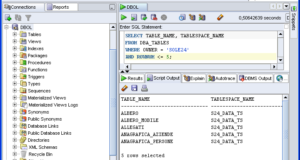REQUEST COMPLIMENTARY SQLS*PLUS LICENCE
Oracle IN condition

The Oracle IN condition (also called the IN operator) determines whether a value or a list of values corresponds to an expression in the specified resulting SELECT, INSERT, UPDATE or DELETE set.
Syntax for the IN condition in Oracle/PLSQL
expression IN (value1, value2, ... value_n);
Parameters and arguments of the condition
- expression – An expression to check.
- value1, value2, … value_n – Values to check the expression.
Note:
The Oracle IN condition will return records where the value of expression coincides with value1, value2, … or value_n.
No more than 1000 constants are allowed in the IN list.
Example with symbols
Let’s consider an example of the Oracle IN condition, using character values.
Below is the Oracle proposal SELECT, which uses the IN condition to compare character values:
SELECT *
FROM customers
WHERE customer_name IN ('IBM', 'Hewlett Packard', 'Microsoft');
This example of the Oracle IN condition will return all strings where customer_name or ‘IBM’, ‘Hewlett Packard’, or ‘Microsoft’. Since SELECT uses *, all fields from the customer_name table will appear in the resulting set.
The example above is equivalent to the following SELECT query:
SELECT *
FROM customers
WHERE customer_name = 'IBM'
OR customer_name = 'Hewlett Packard'
OR customer_name = 'Microsoft';
As you can see, using the IN condition, the SELECT query becomes more readable and more efficient.
Example with numbers
Let’s consider the example of Oracle’s IN condition, using numeric values.
For example:
SELECT *
FROM orders
WHERE order_id IN (10000, 10001, 10003, 10005);
This Oracle IN condition example will return all orders where order_id is either 10000 or 10001 or 10003 or 10005.
The example above is equivalent to the following SELECT request:
SELECT *
FROM orders
WHERE order_id = 10000
OR order_id = 10001
OR order_id = 10003
OR order_id = 10005;
Example of NOT operator usage
And finally, let us consider an example of the IN condition, using the Oracle NOT operator.
For example:
SELECT *
FROM customers
WHERE customer_name NOT IN ( 'IBM', 'Hewlett Packard', 'Microsoft');
This example of the Oracle IN condition will return all lines where customer_name is not ‘IBM’, ‘Hewlett Packard’, or ‘Microsoft’. Sometimes it is much more efficient to list the values that you do not want to get as a result, as opposed to the values that you want to get.
SQL tutorials: How To CREATE TABLE using enterprise manager 11g
MORE NEWS
PreambleNoSql is not a replacement for SQL databases but is a valid alternative for many situations where standard SQL is not the best approach for...
PreambleMongoDB Conditional operators specify a condition to which the value of the document field shall correspond.Comparison Query Operators $eq...
5 Database management trends impacting database administrationIn the realm of database management systems, moreover half (52%) of your competitors feel...
The data type is defined as the type of data that any column or variable can store in MS SQL Server. What is the data type? When you create any table or...
PreambleMS SQL Server is a client-server architecture. MS SQL Server process starts with the client application sending a query.SQL Server accepts,...
First the basics: what is the master/slave?One database server (“master”) responds and can do anything. A lot of other database servers store copies of all...
PreambleAtom Hopper (based on Apache Abdera) for those who may not know is an open-source project sponsored by Rackspace. Today we will figure out how to...
PreambleMongoDB recently introduced its new aggregation structure. This structure provides a simpler solution for calculating aggregated values rather...
FlexibilityOne of the most advertised features of MongoDB is its flexibility. Flexibility, however, is a double-edged sword. More flexibility means more...
PreambleSQLShell is a cross-platform command-line tool for SQL, similar to psql for PostgreSQL or MySQL command-line tool for MySQL.Why use it?If you...
PreambleWriting an application on top of the framework on top of the driver on top of the database is a bit like a game on the phone: you say “insert...
PreambleOracle Coherence is a distributed cache that is functionally comparable with Memcached. In addition to the basic function of the API cache, it...
PreambleIBM pureXML, a proprietary XML database built on a relational mechanism (designed for puns) that offers both relational ( SQL / XML ) and...
What is PostgreSQL array? In PostgreSQL we can define a column as an array of valid data types. The data type can be built-in, custom or enumerated....
PreambleIf you are a Linux sysadmin or developer, there comes a time when you need to manage an Oracle database that can work in your environment.In this...
PreambleStarting with Microsoft SQL Server 2008, by default, the group of local administrators is no longer added to SQL Server administrators during the...















